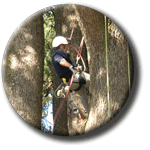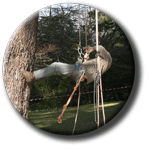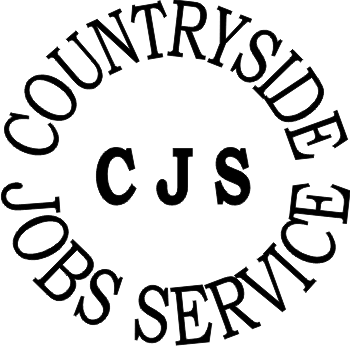Anything
which requires climbing into a tree is almost certainly too dangerous to be
attempted without training.f you want work doing
on your trees, it is a very good idea to get professional advice. If you want
an opinion on whether a tree is diseased or dangerous, or you want to build
near a tree without damaging it, you need professional advice - these two things
particularly are very hard to judge without professional training, although
plenty of people try and get it wrong. It is not good enough to say
'well it looks alright to me', unless you're qualified to say so.
Tree work is not easy, and if you tr yto do it yourself or use
a worker without the proper training is usually neither safe nor cheap, although
it might seem like a cheap option at first! It is especially dangerous to buy
or hire powered machinery such as a chainsaw unless you are qualified to use
it - hire shops are not obliged to check this and few do. As a rule of thumb
anything which requires climbing into a tree is almost certainly too dangerous
to be attempted without training. Unfortunately there are plenty of people who
will try to cut corners, and charge you, the landowner, for the privilege. In
the end, the liability for any mistakes or accidents still rests at least partly
upon you as the person who employs them.
If you decide to use a contractor, it is your responsibility
to check before you appoint somebody. Check qualifications, experience, and
current insurance. A good firm will willingly show you paper evidence of all
these. Ask for references - follow them up - and look at similar work they have
done elsewhere. If they havn't done anything nearby or recently, you might wonder
why not. Discuss what you want done and why. Get a written description of the
work if you can. You may want to ask two or three companies for quotations,
but do not necessarily choose the cheapest - they may not be the best value
for money.
Think very carefully before using the services of any company
which:
• Solicits work door to door. Reputable companies
do not use this method of finding work, and many 'cowboys' do.
• Advertises 'topping' as a service provided. The majority of qualified
arboriculturalists agree that topping
is harmful to trees and is not an accepted practice. If a company advertises
that they do topping they probably don't know what they are doing.
• Uses tree climbing spikes to climb trees that are being pruned. Climbing
spikes can damage trees, and their use should be limited to trees that are
being removed. Very few reputable arboriculturalists now use spikes for any
purpose.
• Can't be traced to a permanent address or has only a mobile phone
number.
Also be wary of fencing, gardening and landscaping firms who
may be very experienced and competent at some aspects of grounds care, but do
not have the experience necessary to do work to trees. Just because they are
good at some aspects of grounds maintenance, does not mean they can do tree
work. If they need to bring in a tree surgeon, make sure you check who it is.
If you want some information about reputable local firms, you could ask your
local council's Tree or Arboricultural Officer if they publish a list.
 Tree consultants don't normally do tree works themselves,
but may well have a close link with a company which does. A tree consultant is
likely to be better qualified and experienced than most tree surgeons and will
be the best person to employ if you need advice on any tree matters, for example
a neighbour dispute, planning application, proposed building, subsidence, drainage
or other matters where there might be serious money or legal issues at stake.
If you pay for any advice from a consultant, it should be written on headed paper,
showing clearly who gave the advice and what their qualifications are. If they
turn out to have given you bad advice you may be able to claim against them for
any damages caused. If you ever need to rely on this, for example in court, or
when making a planning application, this is essential. They will cost a little
more, but this will be money well spent in most cases.
Tree consultants don't normally do tree works themselves,
but may well have a close link with a company which does. A tree consultant is
likely to be better qualified and experienced than most tree surgeons and will
be the best person to employ if you need advice on any tree matters, for example
a neighbour dispute, planning application, proposed building, subsidence, drainage
or other matters where there might be serious money or legal issues at stake.
If you pay for any advice from a consultant, it should be written on headed paper,
showing clearly who gave the advice and what their qualifications are. If they
turn out to have given you bad advice you may be able to claim against them for
any damages caused. If you ever need to rely on this, for example in court, or
when making a planning application, this is essential. They will cost a little
more, but this will be money well spent in most cases.
Consultants (and contractors) should ideally be members of a
professional body. These include:
• Arboricultural
Association U.K. Ampfield House, Ampfield, Romsey, Hampshire SO51 9PA
01794 368717.
• Institute of Chartered
Foresters, UK, 7A St Colme Street, Edinburgh EH3 6AA 0131 225 2705.
• The International Society of Arboriculture.
Contractors are the people who actually do the work to the
tree. Check that contractors are properly trained so they understand their work.
Training bodies include:
• City & Guilds of London Institute, 1 Giltspur
Street, London EC1A 9DD 020 7 294 2468.
• National Proficiency Tests Council,
National Agricultural Centre, Kenilworth, Warwickshire CV8 2LG 024 76696553.
• Royal Forestry Society of England,
Wales and Northern Ireland, 102 High Street, Tring, Hertfordshire HP23
4AF 01442 822028.
 Tree
surgery needs to be done by people who understand what they’re doing and
why. Ask to see similar trees that the contractor has pruned in the past -
perhaps the most important requirement for good tree surgery is a good eye.
A good tree surgeon is also artistic and can see how to prune the tree to leave
it not only healthy and sound, but also with a beautiful shape that is natural
for the species and situation.
Tree
surgery needs to be done by people who understand what they’re doing and
why. Ask to see similar trees that the contractor has pruned in the past -
perhaps the most important requirement for good tree surgery is a good eye.
A good tree surgeon is also artistic and can see how to prune the tree to leave
it not only healthy and sound, but also with a beautiful shape that is natural
for the species and situation.
Be especially careful when choosing a tree contractor. Tree
work is hard, skilled work and potentially very dangerous. The AA (see above)
publishes a directory of approved contractors every year.
Since 5th December 1998, The
Provision and Use of Work Equipment Regulations 1998 (PUWER 98), require all
workers who use a chainsaw to work on or in a tree to be competent to do so.
They should have received appropriate training and obtained a relevant certificate
of competence or national competence award. It is suggested that tree contractors
should do refresher training every five years.
The Lifting
Operations and Lifting Equipment Regulations 1998 (LOLER 1998), also apply
to tree surgery - for example, when somebody is climbing a tree, there should
be somebody else available on site who has been trained in tree rescue; tree
contractors should have their equipment, such as ropes, regularly inspected
by somebody independent. If your tree contractor works alone when up a tree, they are not complying with these regulations and their insurance will almost certainly be invalidated - they are also putting you and themselves at risk.
Tree work contractors should have passed chainsaw operations
assessments set by the National Proficiency Tests Council (NPTC), and should
carry an ID card. If contractors are not properly trained and/or do not follow
industry guidelines (set by FASTCo, the Forestry & Arboriculture Safety
& Training Council, 0131 314 6193) then their insurance will almost certainly
be invalid. Their training certificate and ID card will show what units they
are qualified in. This can be complex as the system changed in 1997, so anyone
qualified before then may have the older documentation. This is still valid.
The information below should give some guidance but you should check with NPTC
if you are in any doubt. The most relevant NPTC units for tree surgery and their
old equivalents are shown below.
Unit no. (from 1997) |
Details |
Equivalent to old units (up to 1996) |
| CS 40 (requires all units below except 41) |
Carry out Pruning Operations |
part of AA 8 |
| CS 41 (requires all units below) |
Carry out Dismantling Operations |
part of AA 9 |
| CS 39 (requires all units below) |
Operate the Chainsaw from a Rope and Harness |
CS 22 |
| CS 38 |
Climb Trees and Perform Aerial Tree Rescue |
SCOTVEC 88157 |
| CS 37 |
Break Down Medium Sized Broad-leaved Crowns |
parts of CS 12, CS 13, and CS 21 |
CS 31a (conifer)
CS 31b (broadleaf)
|
Fell Small Trees |
parts of CS 11 and CS 14 |
| CS 30 |
Maintain the Chainsaw |
CS 20 |
This page was partly derived from "Consultants
and Contractors" produced in 2002 by
Rowan Adams, who was at that time Tree and Landscape Officer for the
Isle of Wight Council.
Reproduced by kind permission.

 Tree consultants don't normally do tree works themselves,
but may well have a close link with a company which does. A tree consultant is
likely to be better qualified and experienced than most tree surgeons and will
be the best person to employ if you need advice on any tree matters, for example
a neighbour dispute, planning application, proposed building, subsidence, drainage
or other matters where there might be serious money or legal issues at stake.
If you pay for any advice from a consultant, it should be written on headed paper,
showing clearly who gave the advice and what their qualifications are. If they
turn out to have given you bad advice you may be able to claim against them for
any damages caused. If you ever need to rely on this, for example in court, or
when making a planning application, this is essential. They will cost a little
more, but this will be money well spent in most cases.
Tree consultants don't normally do tree works themselves,
but may well have a close link with a company which does. A tree consultant is
likely to be better qualified and experienced than most tree surgeons and will
be the best person to employ if you need advice on any tree matters, for example
a neighbour dispute, planning application, proposed building, subsidence, drainage
or other matters where there might be serious money or legal issues at stake.
If you pay for any advice from a consultant, it should be written on headed paper,
showing clearly who gave the advice and what their qualifications are. If they
turn out to have given you bad advice you may be able to claim against them for
any damages caused. If you ever need to rely on this, for example in court, or
when making a planning application, this is essential. They will cost a little
more, but this will be money well spent in most cases.  Tree
surgery needs to be done by people who understand what they’re doing and
why. Ask to see similar trees that the contractor has pruned in the past -
perhaps the most important requirement for good tree surgery is a good eye.
A good tree surgeon is also artistic and can see how to prune the tree to leave
it not only healthy and sound, but also with a beautiful shape that is natural
for the species and situation.
Tree
surgery needs to be done by people who understand what they’re doing and
why. Ask to see similar trees that the contractor has pruned in the past -
perhaps the most important requirement for good tree surgery is a good eye.
A good tree surgeon is also artistic and can see how to prune the tree to leave
it not only healthy and sound, but also with a beautiful shape that is natural
for the species and situation.